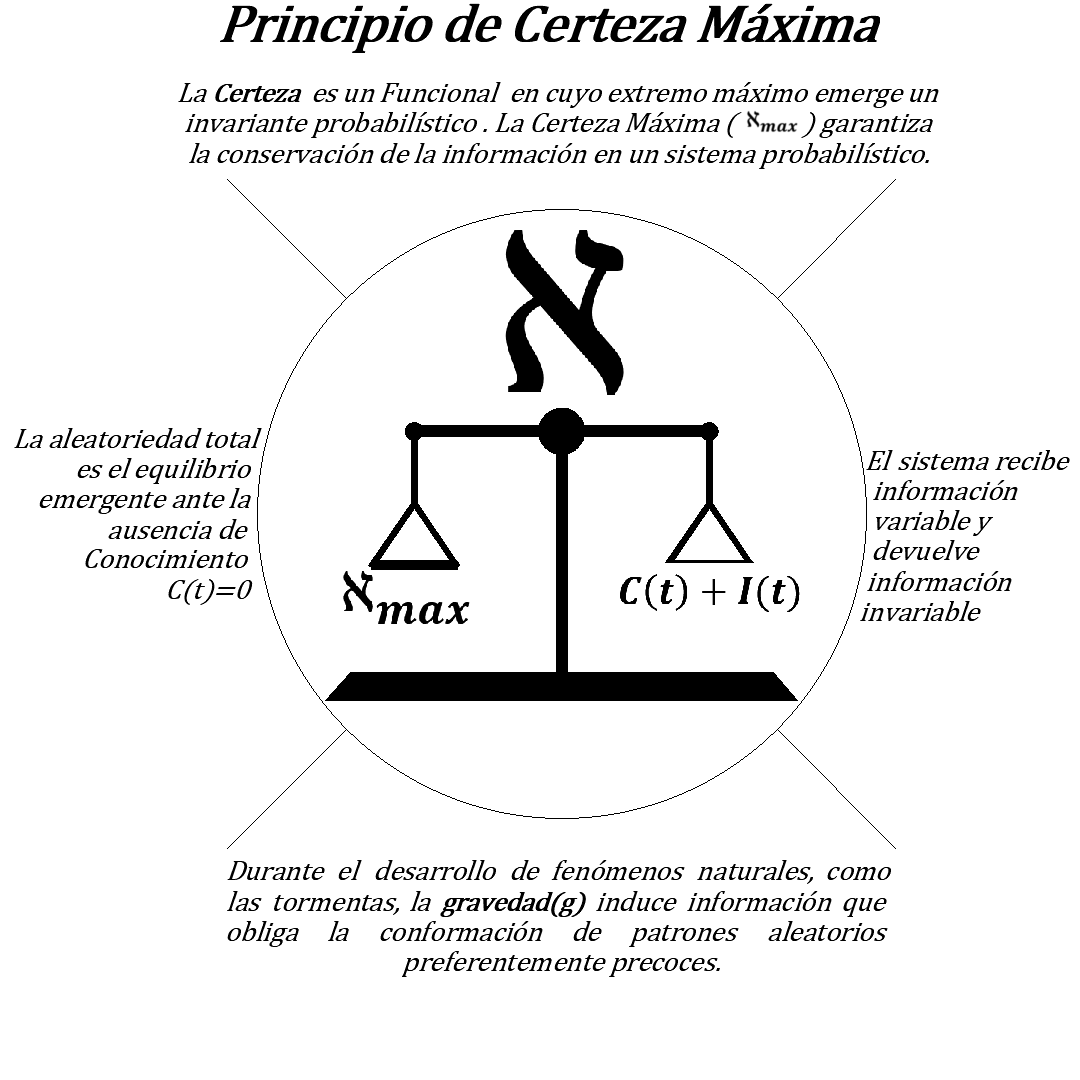Maximum Certainty Principle. Theoretical Analysis of a New Probabilistic Invariant with Applications in the Quito-Ecuador Storm Study
##plugins.themes.bootstrap3.article.main##
Abstract
A new probabilistic invariant named Maximum Certainty (Nmax) is exposed finding the extremum of the Functional Certainty (N) with variational calculus, equivalent to the principle developed by Euler-Lagrange in the deterministic field known as Least Action. Its emergence comes naturally when regard the conservation of the Information received and delivered by a probabilistic system. The invariant Nmax associated to a random variable T, balances the Knowledge function C(t); of each probabilistic density function f(t)max, and Information function: I(t)=-ln(f(t)max). It starts by proving Nmax for the truncated exponential cumulative distribution function and is extended as a principle to other probability distribution families, both continuous and discrete both bounded and unbounded. When the random variable T has units of time, truncated in DT, the cumulative distribution function P(t)max obtained is the most probable time curve among all the possible ones. The modeling of stochastic storm patterns in Quito-Ecuador through the Truncated Quadratic Exponential Distribution (with parameter alfa=9.8) is given as an example of application, among others.
##plugins.themes.revistapolitecnica.stadistisDownloadTitle##
Downloads
Article Details
References
Abramson, N. (1981). Teoría de la información y codificación (J. Menoyo, Trad.; 5.a ed.). Paraninfo. (Original work published 1963). https://www.cartagena99.com/recursos/alumnos/apuntes/Teoria_de_la_Informacion_y_codificacion-Norman_Abramson_ebook-spanish_.pdf
Anzaldo, A., Delgado, J., y Monroy, F. (Eds.). (2007). El legado matemático de Leonhard Euler a trescientos años de su nacimiento. Innovación Editorial Lagares de México. https://www.researchgate.net/publication336015401_El_Legado_Matematico_de_Leonhard_Euler
Bande, M., Galeano P., González J., y Pateiro B. (2008). Estadística Ingeniería Técnica en Informática de Sistemas. Departamento de Estadística e Investigación Operativa Universidad de Santiago de Compostela. http://eio.usc.es/pub/julio/papers/pubdocenteteoriaestadistica.pdf
Beltrán, F. (2017). Lo que esconden las tormentas: Modelación espacio temporal de lluvias en el Ecuador (1ª. Ed.). Autoedición. https://www.amazon.com/-/es/Franklin-Aparicio-Beltran/dp/9942284133
Beltrán, F. (2019, del 22 al 23 de noviembre). Lo que esconden las tormentas: Modelo calibrado de lluvias intensas en el Distrito Metropolitano de Quito y su proyección al Ecuador [conferencia]. III Congreso Iberoamericano de Ingeniería Civil, Quito, Ecuador. https://www.researchgate.net/publication/340818551
Beltrán, F. (2021, 17 de septiembre). Modelo de información de tormentas en Quito (MIT-Q) [conferencia]. Congreso Anual de Meteorología y Calidad del Aire CAMCA-2021, Quito, Ecuador. https://www.usfq.edu.ec/sites/default/files/2021-08/libro-abstracts-camca-2021.pdf
Berdichevsky, V. (2009). Variational Principles of Continuun Mechanics. Springer. https://link.springer.com/book/10.1007/978-3-540-88467-5
Cosentino, P., Ficarra, V., y Luzio, D. (1977). Truncated exponential frequency - magnitude relationship in earthquake statistics. Bulletin of the Seismological Society of America, 67(6), 1615-1623. https://www.researchgate.net/publication/279463293
EMAAP-Q, (2009), Normas de Diseño de Sistemas de Alcantarillado para la EPMAAP-Q, EPMAPS. https://www.aguaquito.gob.ec/Alojamientos/PROYECTO%20LA%20MERCED/ANEXO%202%20NORMAS_ALCANTARILLADO_EMAAP.pdf
Feynman, R., Leighton R., y Sands, M. (2010). The Principle of Least Action. En M. Gottieb y R Pfeiffer (Eds.), Lectures on Physics The New Millennium Edition (Volume II) (pp. 19-1,19-14). Basic Books. https://www.feynmanlectures.caltech.edu/II_19.html
Jaynes, E. (1957). Information Theory and Statistical Mechanics. American Physical Society, 106(4), 620-630. https://doi.org/10.1103/PhysRev.106.620
Krasnov, M., Macarenko, G., y Kiseliov, A. (1992). Cálculo Variacional (C. Vega, Trad.). MIR. (Original work published 1974).
Kreyszig, E. (1994). On the Calculus of Variations and Its Major Influences on the Mathematics of the First Half of Our Century: Part l (A. Shenitzer. Ed.). The American Mathematical Monthly, 101(7), 674-678. https://www.math.unm.edu/~vageli/courses/Ma579/cvar1.pdf
Landau, L., y Lifshitz E. (1994). Mecánica (Volumen 1). Editorial REVERTÉ. https://www.academia.edu/43581613/MECANICA_LANDAU_y_LIFSHITZ
Lévy-Leblond, J. (2002). Conceptos contrarios o el oficio de científico (J. Chabás, Trad.). Tusquets Editores.
Milton, J., y Arnold, J. (2005). Probabilidad y Estadística con Aplicaciones para Ingeniería y Ciencias Computacionales. McGrawHill.
Montgomery, D., y Runger G. (2003). Probabilidad y estadística aplicadas a la ingeniería. (2ª. Ed.). Editorial Limusa.
Palacios, W., Zambrano M. y Escobar D. (2015). Análisis temporal de las lluvias extremas en el DMQ y cálculo de las curvas de Intensidad-Duración-Frecuencia. EPMAPS. https://www.aguaquito.gob.ec/Alojamientos/PALUGUILLO%20BELLAVISTA%20TRAMO%202/An%C3%A1lisis%20temporal%20de%20las%20lluvias%20extremas%20en%20el%20DMQ.pdf
Rose, S. (2010). A First Course in Probability (8ª. Ed.). Pearson Prentice Hall.
Shannon, C. (1948). A Mathematical Theory of Communication. The Bell System Technical Journal, 27(3), https://ia803209.us.archive.org/27/items/bstj27-3-379/bstj27-3-379_text.pdf
Thingbaijam, K., y Mai, M. (2016). Evidence for Truncated Exponential Probability Distribution of Earthquake Slip. Bulletin of the Seismological Society of America, 106(4), 1808-1809. https://doi.org/10.1785/0120150291
Vijay, P. (2014). Entropy Theory in Hydraulic Engineering An Introduction. American Society of Civil Engineers. https://ascelibrary.org/doi/book/10.1061/9780784412725




